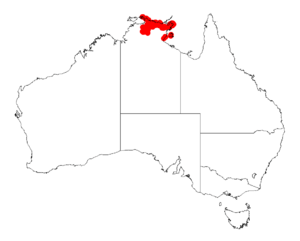Acacia sublanata facts for kids
Quick facts for kids Acacia sublanata |
|
|---|---|
| Scientific classification | |
| Genus: |
Acacia
|
| Species: |
sublanata
|
 |
|
| Occurrence data from AVH | |
Acacia sublanata is a type of shrub that belongs to the Acacia family, also known as wattles. This special plant is found only in a specific part of northern Australia. It is endemic, meaning it naturally grows only in this area and nowhere else in the world.
Contents
About the Acacia sublanata Plant
This shrub usually grows to be about 0.4 to 3 m (1 ft 4 in to 9 ft 10 in) tall. That's like being as short as a small bush or as tall as a small tree! It can grow straight up or spread out a bit. Its branches are covered in fine hairs and have stripes.
Like most Acacia plants, it doesn't have true leaves. Instead, it has special flattened stems called phyllodes that look and act like leaves. These phyllodes are thin, leathery, and grey-green. They are shaped a bit like a triangle with a wide top. Each phyllode is about 4 to 15 mm (0.16 to 0.59 in) long and about the same width. They also have two to four raised lines, which are like veins.
Flowers and Seeds
When the Acacia sublanata blooms, it produces simple inflorescences. An inflorescence is a cluster of flowers on a stem. These flower clusters are usually round, like small balls, or sometimes a bit oval-shaped. They are about 5 to 6 mm (0.20 to 0.24 in) wide and can be up to 8 m (26 ft) long. Each flower-head contains about 30 golden-colored flowers.
After the flowers bloom, the plant forms seed pods. These pods are hairy and feel a bit crusty. They are long and thin, but they have bumps and narrow parts between each seed. The pods can grow up to 14 cm (5.5 in) long and are about 3 to 6 mm (0.12 to 0.24 in) wide. Inside the pods, the seeds are shiny black and oblong-shaped. They are about 5 to 8 mm (0.20 to 0.31 in) long and have a small, fleshy attachment called an aril at one end.
How Acacia sublanata Was Named
The first time this plant was officially described was in 1837. A botanist, which is a scientist who studies plants, named George Bentham gave it its scientific name. He included it in his work about plants collected in southwestern Australia.
Later, in 1987, another botanist named Leslie Pedley changed its name to Racosperma sublanatum. However, in 2001, it was moved back to the Acacia group, and its name became Acacia sublanata again.
Where Acacia sublanata Grows
This plant is found naturally in a region of northern Australia known as the Top End of the Northern Territory. You can find it from the areas around the upper South Alligator River and East Alligator Rivers in the west. It stretches across to Groote Eylandt and the Gove Peninsula in the east.
Acacia sublanata often grows in woodland areas. These are places with many trees and shrubs. It particularly likes to grow in areas where the soil is made of sandstone.

